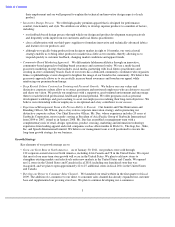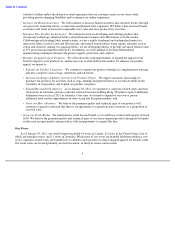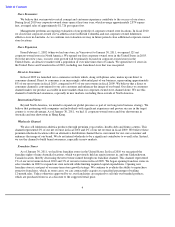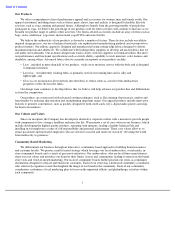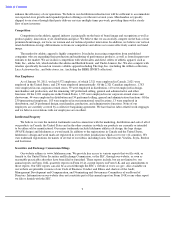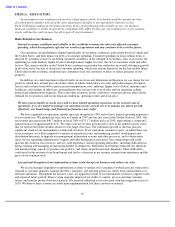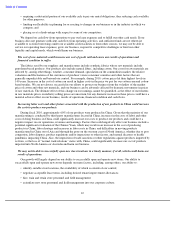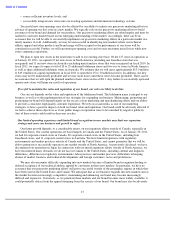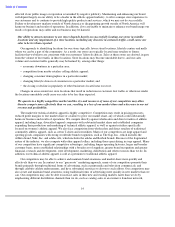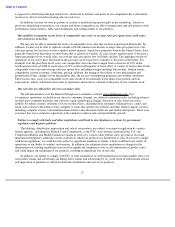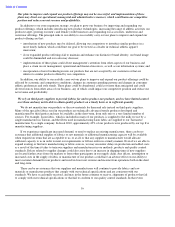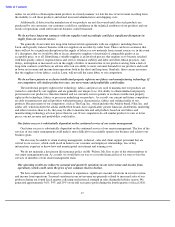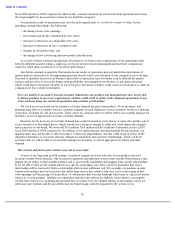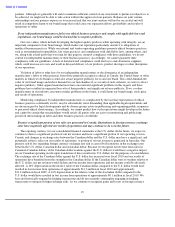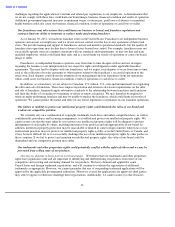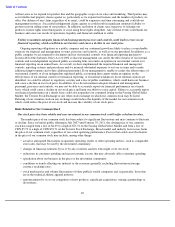Lululemon 2010 Annual Report Download - page 17
Download and view the complete annual report
Please find page 17 of the 2010 Lululemon annual report below. You can navigate through the pages in the report by either clicking on the pages listed below, or by using the keyword search tool below to find specific information within the annual report.
Table of Contents
We depend on cash flow from operations to pay our lease expenses and to fulfill our other cash needs. If our
business does not generate sufficient cash flow from operating activities, and sufficient funds are not otherwise
available to us from borrowings under our available credit facilities or from other sources, we may not be able to
service our operating lease expenses, grow our business, respond to competitive challenges or fund our other
liquidity and capital needs, which would harm our business.
The cost of raw materials could increase our cost of goods sold and cause our results of operations and
financial condition to suffer.
The fabrics used by our suppliers and manufacturers include synthetic fabrics whose raw materials include
petroleum-based products. Our products also include natural fibers, including cotton. Our costs for raw materials are
affected by, among other things, weather, consumer demand, speculation on the commodities market, the relative
valuations and fluctuations of the currencies of producer versus consumer countries and other factors that are
generally unpredictable and beyond our control. For example, during 2010, cotton prices hit their highest levels in
140 years. Increases in the cost of cotton can result in higher costs in the price we pay for our cotton yarn and cotton-
based textiles. We are not always successful in our efforts to protect our business from the volatility of the market
price of cotton and other raw materials, and our business can be adversely affected by dramatic movements in prices
of raw materials. The ultimate effect of this change on our earnings cannot be quantified, as the effect of movements
in raw materials prices on industry selling prices are uncertain, but any dramatic increase in these prices could have a
material adverse effect on our business, results of operations, financial condition and cash flows.
Increasing labor costs and other factors associated with the production of our products in China could increase
the costs to produce our products.
During fiscal 2010, approximately 60% of our products were produced in China. Given that the majority of our
manufacturing is conducted by third-party manufacturers located in China, increases in the costs of labor and other
costs of doing business in China could significantly increase our costs to produce our products and could have a
negative impact on our operations, revenues and earnings. Factors that could negatively affect our business include a
potential significant revaluation of the Chinese Yuan, which may result in an increase in the cost of producing
products in China, labor shortage and increases in labor costs in China, and difficulties in moving products
manufactured in China out of Asia and through the ports on the western coast of North America, whether due to port
congestion, labor disputes, product regulations and/or inspections or other factors, and natural disasters or health
pandemics impacting China. Also, the imposition of trade sanctions or other regulations against products imported by
us from, or the loss of “normal trade relations” status with, China, could significantly increase our cost of products
imported into North America or Australia and harm our business.
We may not be able to successfully open new store locations in a timely manner, if at all, which could harm our
results of operations.
Our growth will largely depend on our ability to successfully open and operate new stores. Our ability to
successfully open and operate new stores depends on many factors, including, among others, our ability to:
12
• requiring a substantial portion of our available cash to pay our rental obligations, thus reducing cash available
for other purposes;
• limiting our flexibility in planning for or reacting to changes in our business or in the industry in which we
compete; and
•
placing us at a disadvantage with respect to some of our competitors.
•
identify suitable store locations, the availability of which is outside of our control;
•
negotiate acceptable lease terms, including desired tenant improvement allowances;
•
hire, train and retain store personnel and field management;
•
assimilate new store personnel and field management into our corporate culture;



